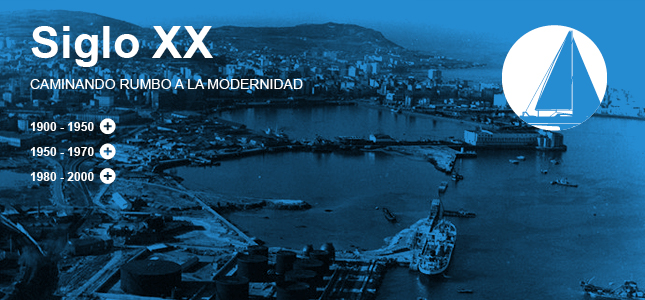20th Century

At the turn of the last century, one the the most ambitious projects in the port's history was presented: the construction of the quays comprising the new harbours, along with a breakwater, the precursor of the current seawall.
In 1906 Eduardo Vila carried out the project for the La Marina Quay and the Parrote dry dock. With its trapezoidal shape, not only did the harbour afford protection for smaller vessels, it also improved the area's unsightly appearance. The work was completed in 1918, providing extra room for the population's traffic, resulting in one of the most beautiful parts of the city, set off by the glazed balconies.
Before the growth of the passenger routes to North America, in 1923 the project for the Transatlantic Quay (now known as the Calvo Sotelo Quay) was presented. After a series of technical, labour and political setbacks, the work was finally finished in 1936.
The great turning point in the planning of the port arrived in the mid-twentieth century, with the approval in 1946 of the General Project of the Port Works and Improvements, which includes as key works to the sea wall, the fishing port in San Diego and the docks of As Animas.
Designed by Eduardo Garcia de Dios, the breakwater, with its 1,336 meters in length, was a determinant factor for the awarding to A Coruña of the first oil refinery in the North Atlantic.
In addition, the Board of Port Works opened its headquarters in 1954. The building, located on the Avenida de la Marina, is still active after the name change and is now the headquarters of the Port Authority.
Work on the installation of the refinery Petroliber began in 1962, coinciding with the final phase of the implementation of the Barrie de la Maza dock, which was completed in 1965, and the implementation of the oil terminal port. The modernization of the port facilities favoured a major boost to activities, placing the port of La Coruna fifth place in Spain in 1960.
In the 70s, the port landscape was completed with the construction of the Centenario Dock to diversify the freight traffic, dominated by fishing and oil, and expanded it to dry bulks.
From the 80s, possibilities for further progress in the port development, ran out, given the limited space on the seafront. Given this situation, together with the growing port activity, generating an increase in the movement of sensitive goods, culminated with the maritime disaster of the
In the hope of developing this project, the most important milestones in the last decade of the twentieth century, was building the new fishing Oza Dock, the opening of Trasatlanticos Dock, and the change of the name from Port Works to Port Authority.
The decade culminated with the signing of the Analysis and Feasibility Study of Alternatives for A Coruña Port Facilities Expansion.
This is the embryo of the future construction of the Outer Port, which highlights the suitability of Punta Langosteira as the construction site of new facilities.
